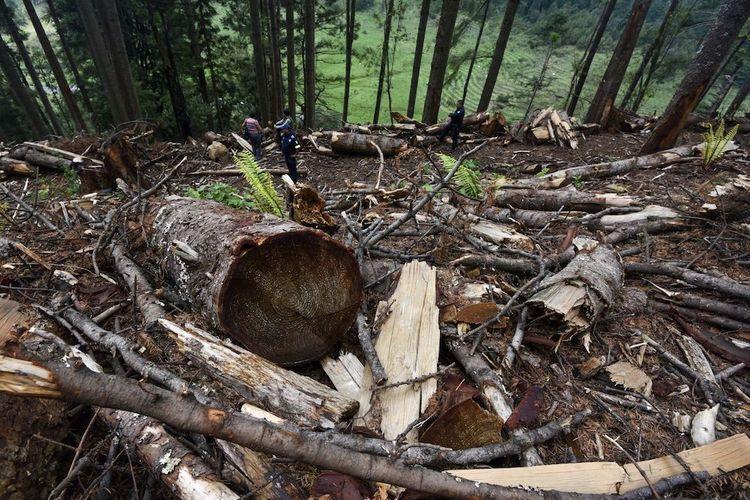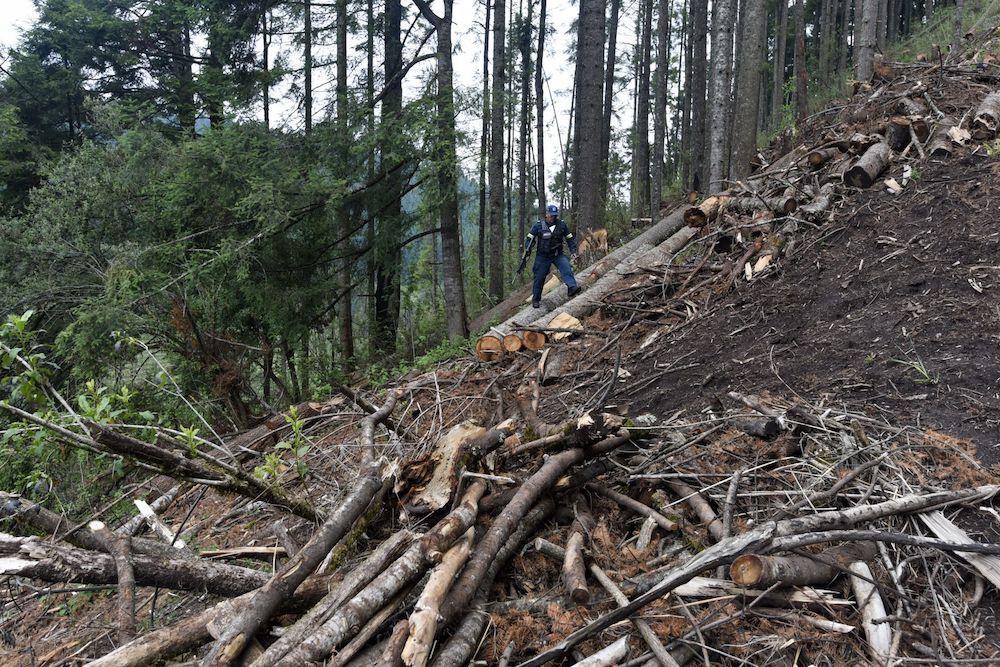With more than 20 years of illegal logging in the Lagunas de Zempoala National Park and the surrounding forests of San Juan Atzingo, the Tlahuica people are clear about the steps to put a stop to it.
The first thing is to declare the region an environmental emergency zone, followed by implementing permanent forest inspection and surveillance, confiscating clandestine sawmills, reviewing sales workshops and encouraging community support to reforest the region.
This is stated in the July 5 communiqué published on the occasion of the most recent demonstration, in which they printed on blankets the phrase “The Water Forest dies from illegal logging in the Zempoala Lagoons” and blocked the Santiago-Chalma highway, State of Mexico.
The Water Forest is what is known as the forest area that runs through the Protected Natural Areas (ANP) of El Tepozteco, Chichinautzin, Zempoala, Ajusco, Desierto de los Leones, in the states of Morelos, State of Mexico and Mexico City.
Although there are no official figures for the impact of clandestine logging in this forest, Greenpeace has a record of 2,400 hectares lost per year.
“Logging is a problem that has been allowed to grow too much, to the extent that talamontes are already doing it in an organized way, equipping themselves with vehicles, vans, communication radios and weapons. They are not the ones who cut to survive, now it's a high-profit business,” Eduardo González Gómez, president of the Elected Provisional Indigenous Council of Atzingo, explained in an interview.

Clandestine logging in Ocuilan, State of Mexico. Photo: Crisanta Espinosa/Cuartoscuro.com
Talamontes on the road
San Juan Atzingo is the main town of the Tlahuica indigenous people, in the municipality of Ocuilan, State of Mexico. It is located in the vicinity of the Zempoala Lagoons, which have had an ANP decree since 1936.
Unofficially, community members of San Juan Atzingo have documented that 6,000 hectares have been devastated in the last 20 years in the Lagunas de Zempoala National Park.
According to González, establishing the area as an environmental emergency, a category that is usually applied in cases of pollution, would show that there is no priority program to address logging.
“It is true that it is declared a Protected Area, but in reality it is an unprotected area. We know that for the authorities it would be to recognize that there is a failed policy in declaring an ANP as an environmental contingency zone,” he said.
In 2007, the Federal Attorney for Environmental Protection (Profepa) implemented the program initially called “Zero Tolerance for Clandestine Logging”, with an emphasis on Michoacán and the State of Mexico. It was later extended to Morelos and Mexico City.
In its 2020 activity report, Profepa acknowledged that in the area of forest resources, it carried out 1,198 inspections, 905 surveillance tours and 106 operations that year.
These actions resulted in the precautionary insurance of 5,740
cubic meters of wood, 611 tons of charcoal, 150 vehicles, 155 equipment and tools, as well as the closure of 17 sawmills across the country.
Despite the numbers, every year there are more frequent images of talamontes in vans and trees lying on the side of roads in Ocuilan.
“We know that in the towns of Santa Martha and Santa Lucía there are nine clandestine sawmills where they process the trees they cut down on a daily basis. We have denounced it,” said the president of the Indigenous Council during the interview.
“We believe that there is complicity between loggers and those who work in the dependencies. We noticed that when operations are carried out, they don't go out into the forest to cut down during that week, they take cover,” he added.
In the town of Santa Martha, less than 7 kilometers from San Juan Atzingo, there is also a National Guard headquarters. Last May, videos of a confrontation with armed loggers were released.
Three years earlier, Félix Alberto Linares González, the municipal president of Ocuilan, joined a demonstration against illegal logging, demanding support from the federal government with the presence of this body and acknowledging that they were overwhelmed by gangs of talamontes.
Fewer actions, more complaints
In 2020, the Ministry of Environment and Natural Resources reported that there were 122 critical forest areas in the country, of which six were in the State of Mexico.
However, the number of complaints of illegal logging is higher than in the rest of the country's entities.
From 2018 to 2021, the Attorney General's Office registered 4,989 complaints of unauthorized logging. According to information provided through transparency, 724 belong to the State of Mexico, with 10 inspectors assigned to the entire entity.
Then there are Michoacán with 524, Puebla with 392 and Mexico City with 301 reports. 2019 was the year that surpasses the others with a total of 1,380.
“Logging is a serious phenomenon that has grown in recent years. It's not just a failure of Profepa, it's of all forest policy and to address it, it's necessary to promote forest management,” said René Orantes, president of Bosques and Governance A.C.
So far, in the town of Tlahuica, they carry out their own reforestation activities both in San Juan Atzingo and in the Lagunas de Zempoala National Park.
After the demonstration a month ago, they had a meeting with authorities where they raised their requests, but the only answer was a National Guard operation that has not generated changes.



Comentarios (0)